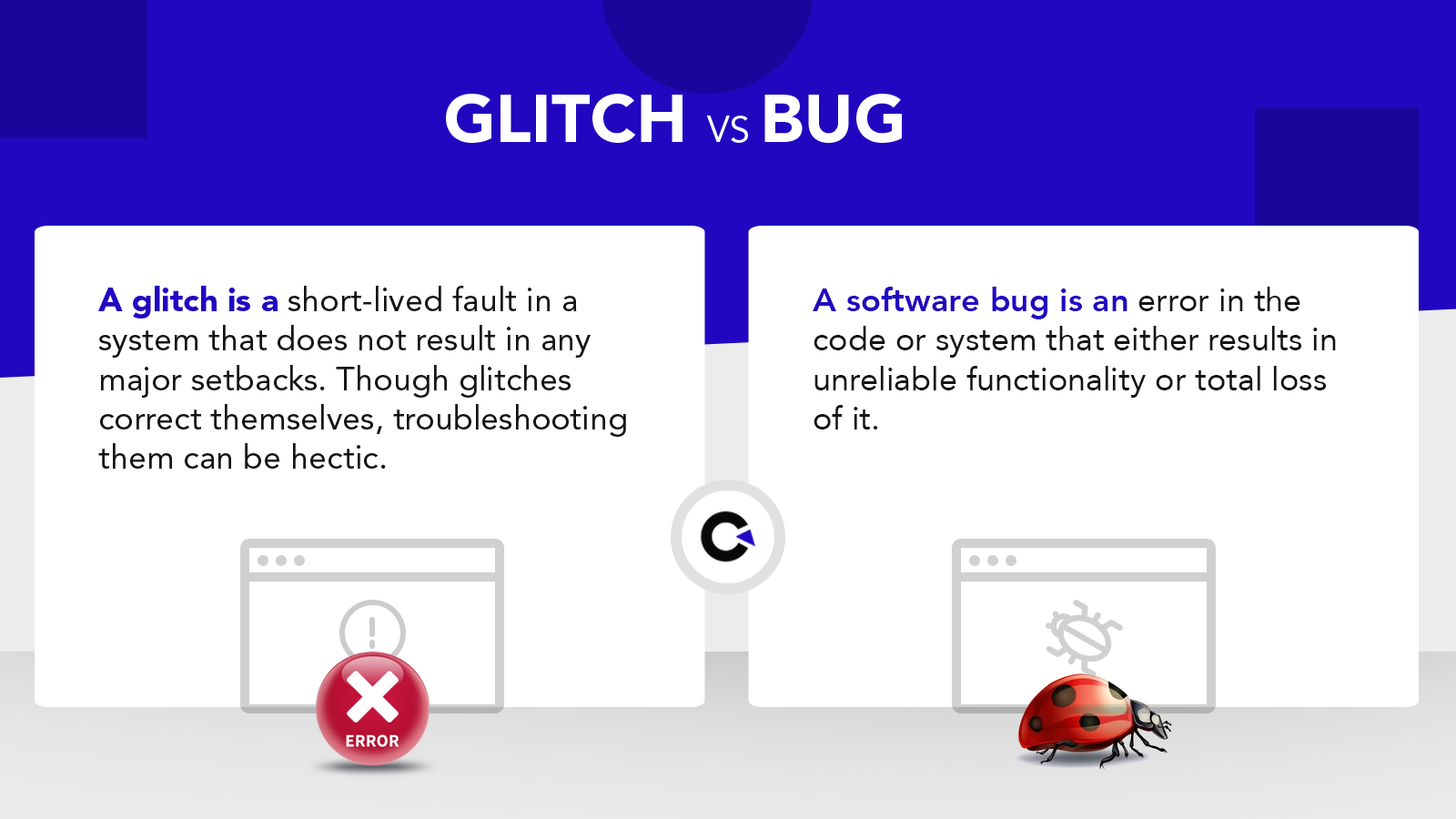|
Listen to this blog
|
Prevention is better than cure is a great saying that even applies to the software development lifecycle. But it is almost impossible to develop software without any bugs on the very first try. So in order to keep up with the ever-growing need for rapid software development, it is vital for us to minimize the time taken to fix a bug. So it is very important to know the different types of software bugs detected during software testing as the complete knowledge of the type of bug you are dealing with will be instrumental in helping you understand the severity and in turn sort your priorities accordingly.
But before we explore the various types of software bugs, let’s first look into what classifies as a software bug. A software bug can be defined as an error or a fault that can render a computer program or even an entire system to crash or malfunction. So you will not get the desired or expected output despite providing a valid input. Though a glitch is different from a software bug, few might assume both to be the same. Due to the random nature of software glitches, it can be very difficult to find the cause and solve it like a software bug. But you might get lucky as glitches are known to correct themselves.

Origin of the Term ‘Bug’
Before dive in to explore the different types of software bugs, let’s take a look at some interesting trivia related to the term ‘bug’. The first-ever bug in a computer was reported by Grace Hopper back in 1946 and there is an interesting story behind how the term ‘bug’ came into use.

But some records suggest that the term ‘bug’ was used years back to denote an issue in a system.

What are the Different Types of Software Bugs?
Let’s take a list of the various types of software bugs and then explore them one by one.
- Functionality Bugs
- Performance-based Bugs
- Usability Issues
- Safety Issues
- Compatibility Issues
- System-Level Integration Bugs
- Unit Level Bugs
Functionality Bugs
Every element in an application or a website will have a purpose for its existence. At times, it is possible for a few of these elements to not function as per the need or expectations. So such errors can be termed as functional bugs. The severity of these types of bugs could also be in different ranges. To bring that into perspective, a random non-functioning button that isn’t responding to clicks is also a functionality issue, and a malfunctioning login functionality that isn’t letting the users use the software is also a functionality issue. Owing to the broad nature of this type of bug, it is one of the most common bugs you will encounter. You have to be careful and not list every single bug you find under this category. Instead, you should take a closer look and classify it accordingly.
Performance-based Bugs
But just because a function works, doesn’t mean that everything is fine. According to a report, a delay of just one second decreases the customer’s satisfaction by 16%. Now, let’s say you are at the payment gateway and have entered your password or the OTP. The payment has to be verified and a success message has to be displayed in a very short span of time. If it takes 5 minutes for the success message to be displayed, then the user would be livid with your software. Similarly, if it works smoothly only once every 5 times, you would have to be counting on your luck to get that successful message. So speed, stability, resource consumption, etc. are a few performance issues that one might face.
Usability Issues
Over the years the number of fields in the sign-up form has been on the decline and usability is one of the major reasons. If it seems like too much work, users might shy away from creating an account or using the product altogether. You might have developed a great feature that can make a task easier for the user. But if the feature is hidden away in some menu making it hard for the user to find, it most probably will remain unused. There can also be workflow bugs that can make navigation through the software very difficult.
Accessibility issues are some of the most overlooked types of usability issues that make your product inaccessible to people with disabilities. As one of the leading QA companies, we provide the best web accessibility testing services and believe that everyone should have equal access to the various applications and websites in the market. Now let’s take a look at the few common accessibility issues that are usually found.

Safety Issues
With so much of our personal information at stake, safety and privacy have become major concerns for many users. The Covid-19 pandemic also resulted in a surge of security breaches as many products were left vulnerable due to their lack of focus on security. So make sure to look out for the following security issues.
- Encryption errors
- Buffer overflows
- Vulnerabilities in XSS
- Susceptibility to SQL injections
- Weak authentication
- Loopholes in role-based access
- Insecure deserialization
- Using components with known weaknesses
- Security misconfiguration
Compatibility Issues
If we take a mobile application as an example, compatibility is one mammoth challenge that the software development team has to overcome as there are so many mobile devices that are available in the market today. Each of these devices has its own display size & resolution, operating system, processors, and so on. So if you face any issues with a certain specification, then you would have to note it down. If you are developing a website, then you have to make sure it works fine across mobile devices, tabs, and computers. So just because everything works well in the defined circumstances, you can’t expect it to work the same way in real-world scenarios that have a lot of diversity.
System-Level Integration Bugs
Though the code for the different units of the software will be written by different software developers, it must all work together seamlessly. But it is not something that happens every time and you might encounter such issues when you are testing. You might something weird happening in the UI, or you might even witness memory overflow issues because of such bugs. So you can’t directly assume it is a UI issue as it might be caused due to the inconsistencies or incompatibilities across components. This makes it very hard to locate and resolve the issue as one would have to examine a larger chunk of code to identify the problem. So make sure to be extra careful when handling such complex issues.
Unit Level Bugs
Agile teams make use of unit tests to detect issues at the early stages of the software development so that they can be spotted and fixed easily. As a prominent agile testing services provider, we always focus on unit testing in all our projects. So it is highly important for you to know about unit-level bugs. If you are unaware of what unit tests are, they are nothing but the tests that are executed once a few models of the software have been developed. For example, if the sign-up page has been successfully developed, then the testers can verify that functionality alone with maximum coverage. Beyond the functionality, one could check if the data fields are accepting inputs as per the expectations. If the password must include both upper case and lower case letters, then it should not accept a password if this condition isn’t fulfilled.
The Other Different Types of Software Bugs
We have seen the major types of software bugs that you might come across while testing. Now we will be just skimming through the few other bugs that you should know about. The code might have syntax errors that prevent the code from compiling properly. Aspects like a missing character or bracket could cause such issues. Likewise, there might be unnecessary code duplication that is just making the software more bulky and slow. Apart from that, there could be logical errors in the code that can cause loss of functionality or even crash the application. Remember the example under the unit level bugs? You might face such out-of-bound bugs outside of unit testing too.
The Severity of the Different Software Bugs
By now you would have a pretty good idea of what types of software bugs will be severe and which ones have to be prioritized. Even if there is any confusion, the following example of a few bugs in an e-commerce website will help you get a crystal clear idea.
- Critical – If there is an issue that is preventing the users from even accessing the site due to a server issue or not allowing you to place an order, then that should be termed critical as all major functionalities have been blocked.
- High-level – This might also seem like a critical bug, but it is something that reduces functionality and not something that totally destroys it. For example, if you are able to access the site and place an order but not able to track the delivery. Here the main functionality is working, but still, there is a lot of inconveniences caused to the user while performing the main functionality (Shopping).
- Medium level – Minor or less important functionalities that impact a user’s experience with the product can be categorized here. A broken link or navigation issues are perfect examples.
- Low level – Bugs in this level will most probably be UI issues like alignment, typos, color issues, and so on.
Prioritization
Conventionally, many would assume that only the critical bugs should be resolved at the earliest. Though severity plays a major role in triaging which bugs to resolve first, complexity should also be considered. Critical bugs should get the main focus irrespective of how complex it is. But along with it, even small typos or issues that can be resolved much effort should also be fixed without any delay. It doesn’t matter if the bug is severe or not, a bug is still a bug and our plan should always be to fix it at the earliest. Highly severe bugs can be prioritized based on complexity. Whereas moderately severe bugs should be fixed by the next update.
Conclusion
We hope you had a good time reading our blog and now have a pretty good idea of the different types of software bugs you might have to deal with when testing. This is a list of the most common bugs you might face, there might be scenarios where you face bugs that are more complex or different in nature. But this list is a good place for you to start and then slowly up your skills as you move forward in your testing career.





















Comments(0)